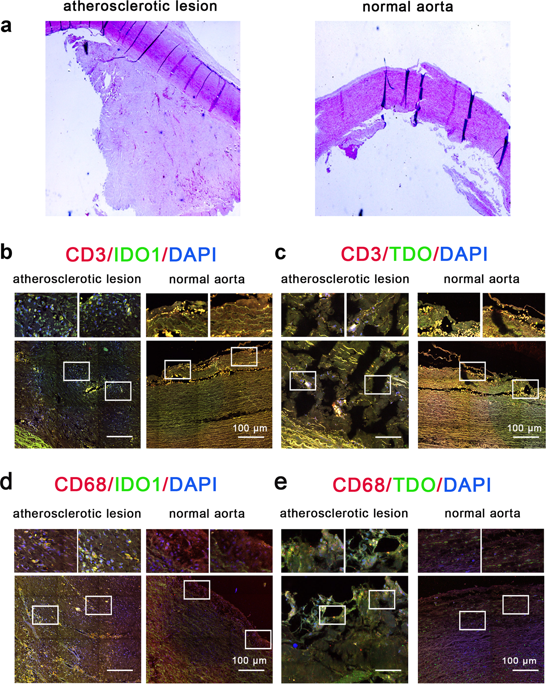Signal Transduction and Targeted Therapy ( IF 40.8 ) Pub Date : 2019-07-19 , DOI: 10.1038/s41392-019-0058-5 Heng Liang 1 , Mantian Chen 2 , Fangfei Qi 1 , Lei Shi 1 , Zhenzhen Duan 1 , Ruoyu Yang 1 , Jinchao He 1 , Bin Lou 3 , Yigang Li 2 , Qing Yang 1

|
The discrepancy of indoleamine 2, 3-dioxygenase 1 (IDO1) function in atherosclerosis has been noted. Compared to the protective effect of IDO1 against established atherogenesis, the role of IDO1 in the developmental process of atherosclerosis is still unclear. Here, the expression patterns and activities of IDO1 and its isoenzyme tryptophan 2,3-dioxygenase (TDO) in aortas and blood samples of patients with atherosclerosis were investigated. IDO1 and TDO were colocalized with CD3-positive lymphocytes and CD68-positive macrophages in atherosclerotic lesions. The expression and activity of IDO1 and TDO increased with the grade of the histological classification in early atherosclerosis (grade I, II), but the increase did not continue in advanced atherosclerosis (grade III). Treatment of THP-1 macrophages (THP-M) with oxidized low-density lipoprotein (oxLDL) induced the expression of IDO1 via the PI3K/Akt/NF-κB pathway, indicating the potential function of IDO1 in foam cells. Before and after treatment with oxLDL on THP-M, IFN-γ-induced IDO1 exhibited different degrees of promotion on foaming, inflammatory factor production and cell apoptosis. Finally, we found that the IDO1 inhibitor 1-methyl-tryptophan could elevate the high-density lipoprotein cholesterol level in serum and reduce the area of the aortic atherosclerotic lesions in high-fat diet-fed ApoE−/− mice. Our study indicated that IDO1 played a complicated and unfixed role in the entire process of atherogenesis, despite the atheroprotective role in established atherosclerosis. IDO1 also had proatherosclerotic functions in the developmental stages of atherosclerosis. Modulation of IDO1 could be a good method for alleviating atherosclerosis.
中文翻译:

吲哚胺 2, 3-双加氧酶 1 在动脉粥样硬化发展阶段的促动脉粥样硬化功能。
吲哚胺 2, 3-双加氧酶 1 (IDO1) 在动脉粥样硬化中的功能差异已被注意到。与IDO1对已形成的动脉粥样硬化形成的保护作用相比,IDO1在动脉粥样硬化发展过程中的作用仍不清楚。在此,研究了动脉粥样硬化患者的主动脉和血液样本中 IDO1 及其同工酶色氨酸 2,3-双加氧酶 (TDO) 的表达模式和活性。IDO1 和 TDO 与动脉粥样硬化病变中的 CD3 阳性淋巴细胞和 CD68 阳性巨噬细胞共定位。早期动脉粥样硬化(I、II级)中IDO1和TDO的表达和活性随着组织学分级的分级而升高,但晚期动脉粥样硬化(III级)中IDO1和TDO的表达和活性不再持续。用氧化低密度脂蛋白 (oxLDL) 处理 THP-1 巨噬细胞 (THP-M) 通过 PI3K/Akt/NF-κB 途径诱导 IDO1 表达,表明 IDO1 在泡沫细胞中的潜在功能。在THP-M上用oxLDL处理前后,IFN-γ诱导的IDO1对泡沫、炎症因子产生和细胞凋亡表现出不同程度的促进作用。最后,我们发现IDO1抑制剂1-甲基色氨酸可以提高高脂饮食喂养的ApoE −/−小鼠血清中的高密度脂蛋白胆固醇水平,并减少主动脉粥样硬化病变的面积。我们的研究表明,IDO1 在动脉粥样硬化的整个过程中发挥着复杂且不固定的作用,尽管在已形成的动脉粥样硬化中具有动脉粥样硬化保护作用。IDO1在动脉粥样硬化的发展阶段也具有促动脉粥样硬化的功能。调节IDO1可能是缓解动脉粥样硬化的好方法。











































 京公网安备 11010802027423号
京公网安备 11010802027423号